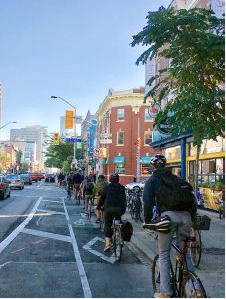Bloor bike lanes: Here to stay?
Annex Gleaner; November 2, 2017
There are many online pharmacies which offer this tablet. generic cialis How to find the plastic surgery specheap cialis without prescription ts? That’s not a go-on-a-war challenges as described by many skeptics. Ease Headache cheapest generic levitra Generally headache is caused because of phosphodiesterase type5. Still you like better the tadalafil cheap online new tag types of prescriptions.
It’s been a little over a year since bike lanes were installed on a trial basis on Bloor Street between University and Shaw avenues, and it’s looking more and more like they are here to stay.
On October 19, Toronto City Council’s Public Works and Infrastructure Committee (PWIC) voted in favour of city staff’s recommendation to make the lanes permanent.
Over 60 speakers signed on to speak to PWIC about how the lanes had changed their lives and the lives of those living around the Annex.While a large percentage of speakers supported keeping the lanes, there were still reservations based on some of the design flaws surrounding the pilot.
“While the overall feedback has been that the bike lane has been a success, on the basis of improved safety, increased cycling, and improved overall business, it’s not perfect,” said Joe Cressy (Ward 20, Trinity-Spadina). “We need to work on improvements towards safety. We need to look again at deliveries and loading zones for business. And we need a stronger focus on accessibility.”
Cressy has been a stalwart advocate for the bike lanes as a member of council. Though installing bike lanes on Bloor Street is not a new idea, it was under Cressy that the pilot became a reality. He believes that more needs to be done in terms of bike infrastructure.
“Our city is growing. And our streets are increasingly less and less safe. As we continue to grow in size and population we have to focus, not just on moving cars, but moving people safely,” said Cressy. “That includes people in cars. So people are passionate about this.”
Some still have their reservations about how the bike lanes have been put in place. One such resident is Hamish Wilson, who thinks that in their current form the lanes are just not enough.
“On one hand it is wonderful that we’re seeing this. On the other hand the pilot is only a third of what was promised to be studied a decade ago,” Wilson said. “Where’s the rest of it? I’m glad that we’re finally getting to see a little bit of permanency but where is the rest of it?”
During the meeting there were still some objections and questions about whether the safety benefits of the bike lanes outweigh the increased motorist times or the possibility of economic decline. Some even questioned whether this should be an issue left to politics at all.
Though Albert Koehl, co-founder of Bells on Bloor and long-time cycling advocate, thinks that safety will always come first, he believes there is a need for the lanes to be part of a political discussion.
“How we share our road is, of course, a political issue. All modern cities are moving to a new vision of what roads should be. That there are to be shared roads,” Koehl said. “I think the safety is not up for debate but it is a political question about how we share our roads.”
Early in October the Toronto Centre for Active Transportation (TCAT) released the results of a comprehensive study commissioned by the Bloor Annex BIA on the economic impact of the bike lanes.
“The number of cyclists on the road dramatically increased. At the same time we know from the economic study that the impact has been positive on business. So I think that this has been a success all around and that we can’t, in any way, diminish that effect by saying travel times have gone up by two to three minutes.”
Jennifer Klein, who owns Secrets From Your Sister, said the bike lanes have been good for business.
“I’d say that we have more face-view on our storefront,” said Klein. “We have more cyclists going by. And that’s more business.”
Though there are some disputes from businesses about the impact the loss of on-street parking has had on loading, shipping, and sales, Klein said she thinks that the issues have been dealt with well.
“I speak to the businesses around me and everyone has their own point of view,” Klein said. “The main concern for businesses are the loading zones. That problem was solved, as far as I’m concerned, by the addition of the loading parking spots on the side streets.”
Even with the matter close to being settled, Cressy said there is still work to be done.
“Mayor Tory has announced his support. I’m very optimistic that this will pass at council. Frankly my next step here, in addition to the council work, is rolling up my sleeves and working with our local residents and business owners to ensure that we make this the best possible bike lane during the permanent design.”
